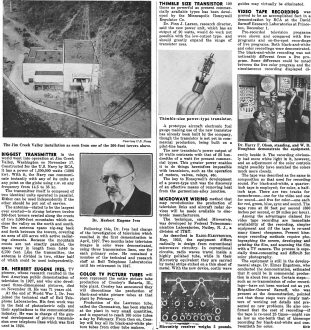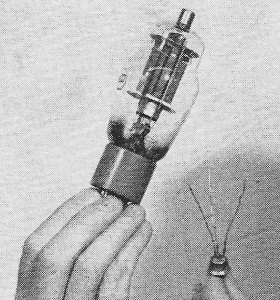|
January 1954 Radio-Electronics
 [Table of Contents] [Table of Contents]
Wax nostalgic about and learn from the history of early electronics.
See articles from Radio-Electronics,
published 1930-1988. All copyrights hereby acknowledged.
|
For many years,
Radio-Electronics magazine ran a monthly feature entitled "The Radio Month,"
which contained news of industry events, personnel hirings and promotions,
product introductions, inventions, etc. This January 1954 issue introduced
something called "microstrip" to the world. Unlike a lot of new concepts billed
as breakthrough, paradigm changing discoveries that you never hear about again,
this one caught on. Practically every wireless device on the market today has a
microstrip substrate of some sort. It was developed by a division of IT&T called
the Federal Telecommunication Laboratories. Also in the news was a thimble size
transistor 100x as powerful as present commercially available types. Made by
Minneapolis Honeywell Regulator Company, it had a whopping 20-watt output (no
mention of operational frequency).
The Radio Month - Microstrip, Biggest Transmitter, Transistor
 Microwave Wiring method that may revolutionize the production
of television links and aircraft radar devices will be made available to electronic
manufacturers. Microwave Wiring method that may revolutionize the production
of television links and aircraft radar devices will be made available to electronic
manufacturers.
The technique, called Microstrip, was developed by Federal Telecommunication
Laboratories, Nutley, N. J., a division of IT&T.
As described in Radio-Electronics, May, 1952, the equipment differs radically
in design from conventional microwave circuitry. In conventional circuits, radio
waves travel inside a highly polished tube, while in their Microstrip equivalent
they are carried by metal strips etched on a thin sheet of metal. With the new device,
costly wave guides may virtually be eliminated.
The Radio Month
Color TV Picture Tubes will soon represent the entire picture
tube production of Crosley's Batavia, Illinois, tube plant. Crosley has announced
they will discontinue the production of black-and-white picture tubes at that plant
by February.
Production of the Lawrence tube, called the Chromatron, has been started at the
plant in very small quantities, and is expected to reach 100 color tubes a day by
February. From then on, Crosley will buy all its black-and-white picture tubes from
other tube makers.

Thimble-size power-type transistor.
Thimble Size Transistor 100 times as powerful as present commercially
available types has been developed by the Minneapolis Honeywell Regulator Co.
Dr. Finn J. Larsen, research director, said the new power unit, which has an
output of 20 watts, would do work not possible with the low-output types. and should
greatly expand the range of transistor uses.
A prototype aircraft electronic fuel gauge making use of the new transistor has
already been built by the company, though the transistor is not yet in commercial
production, being built on a pilot-line basis.
The new transistor's power output of 20 watts contrasts with that of 20 hundredths
of a watt for present commercial types. This greater power enables it to do things
heretofore impossible with transistors, such as the operation of motors, valves,
relays, etc.
The key to Honeywell's development of a power-type unit was the discovery of
an effective means of removing heat from the germanium-alloy junction.
Posted February 25, 2022
|










